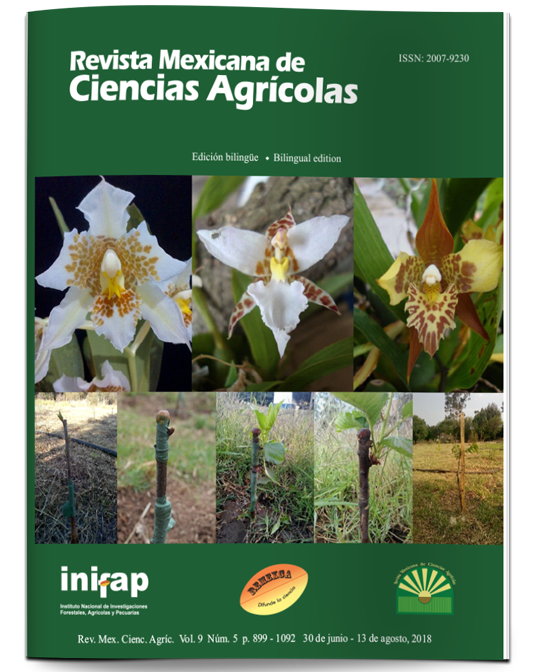Chemical control of linear rust at different stages of wheat development in Terrenate, Tlaxcala
DOI:
https://doi.org/10.29312/remexca.v9i5.1510Keywords:
Puccinia striiformis f. sp. tritici, chemical control, protection strategy, yield lossesAbstract
In Mexico, the main production area for temporary wheat is located in the High Valleys of Central Mexico, where the linear rust (Puccinia striiformis f. sp. tritici Eriks) has become the main problem in recent years, being much more aggressive than leaf rust (Puccinia triticina Eriks). In order to know the most appropriate stage for the application of fungicides for the control of the disease, four commercial formulations and different protection strategies were used, seeking to expand the knowledge in the control of the linear rust in susceptible varieties and thus improve the production of bread wheat under temporary conditions. The present investigation was carried out during the spring-summer cycle, 2015 using the Nana F2007 variety in the municipality of Terrenate, Tlaxcala, Mexico. The best protection strategy was 2, which corresponds to the application of systemic fungicides 45 days after sowing (dds) and in anthesis (70 dds), which was associated with the highest yield. The fungicides that showed the best control over linear rust were the mixture of Axozistrobina+Propiconazole (QUILT®) and Tebuconazole (Folicur 250EW), with which the highest yield values and statistically similar effects were obtained. The results indicate that it is necessary to apply fungicides to control the disease, otherwise the yield losses could be 53% between strategies and up to 84% without application of fungicide.
Downloads
Downloads
Published
How to Cite
Issue
Section
License
The authors who publish in Revista Mexicana de Ciencias Agrícolas accept the following conditions:
In accordance with copyright laws, Revista Mexicana de Ciencias Agrícolas recognizes and respects the authors’ moral right and ownership of property rights which will be transferred to the journal for dissemination in open access. Invariably, all the authors have to sign a letter of transfer of property rights and of originality of the article to Instituto Nacional de Investigaciones Forestales, Agrícolas y Pecuarias (INIFAP) [National Institute of Forestry, Agricultural and Livestock Research]. The author(s) must pay a fee for the reception of articles before proceeding to editorial review.
All the texts published by Revista Mexicana de Ciencias Agrícolas —with no exception— are distributed under a Creative Commons License Attribution-NonCommercial 4.0 International (CC BY-NC 4.0), which allows third parties to use the publication as long as the work’s authorship and its first publication in this journal are mentioned.
The author(s) can enter into independent and additional contractual agreements for the nonexclusive distribution of the version of the article published in Revista Mexicana de Ciencias Agrícolas (for example include it into an institutional repository or publish it in a book) as long as it is clearly and explicitly indicated that the work was published for the first time in Revista Mexicana de Ciencias Agrícolas.
For all the above, the authors shall send the Letter-transfer of Property Rights for the first publication duly filled in and signed by the author(s). This form must be sent as a PDF file to: revista_atm@yahoo.com.mx; cienciasagricola@inifap.gob.mx; remexca2017@gmail.
This work is licensed under a Creative Commons Attribution-Noncommercial 4.0 International license.



